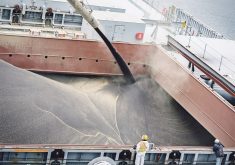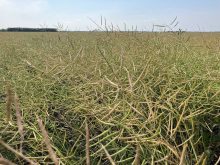Winnipeg, Sept. 7 (CNS Canada) – Canada grew a million more tonnes of canola in 2015/16 than originally reported, according to updated numbers from Statistics Canada released in connection with the Stocks of Principal Field Crops as of July 31 report on September 7. The unexpected revision to the old crop production now has many industry participants questioning just how large the current crop is.
Canadian canola stocks, as of July 31, were pegged at 2.016 million tonnes by StatsCan, which compares with 2.542 million at the same point the previous year. However, supply/demand numbers heading into the report had pointed to a carryout closer to one million tonnes, and the bigger than expected ending stocks were largely explained by a revision to the size of the crop grown in 2015.
Read Also

Potato farm requires year-round management
The most recent Open Farm Day in Alberta showcased agricultural producers across the province educating the general public about the process that is required is to get food to their table.
Just two weeks after the last official production estimates, StatsCan has now revised its 2015/16 canola production estimate 1.2 million tonnes higher, to 18.4 million tonnes.
“That’s a pretty hefty jump,” said Mike Jubinville, of ProFarmer Canada. “This now seriously calls into question StatsCan’s current 2016/17 crop at 17.0 million tonnes as potentially grossly understated,” he added.
“Today’s report basically confirms that we’ll see upward revisions to this year’s crop from the August report for canola,” said Jerry Klassen, manager of the Canadian office for Swiss-based GAP SA Grains and Products in Winnipeg. “This causes traders to second-guess the previous StatsCan numbers,” he added noting that the stocks report was “neutral to bearish” for canola with large increases to this year’s crop now expected.
“Nobody believes anything Statistics Canada comes out with anymore,” said analyst Wayne Palmer, of AgriTrend Marketing noting that the government agency can make revisions going back as far as two years. While the StatsCan numbers are questioned, he said the lack of confidence in the official data was also tied to the general belief that farmers typically underreport their crops in order to try and generate higher prices.
Solid demand will work to counter the larger supplies, but any concerns over tightening supplies have subsided, said Jubinville.
Palmer agreed that demand was there for the larger canola supplies, but added that prices were unlikely to see much movement during the harvest period over the next month.
Looking at the other crops, total wheat ending stocks, at 5.2 million tonnes, were down from the 7.1 million tonnes at the same point the previous year but a bit higher than expectations.
The slightly larger than expected wheat supplies show that domestic feed use was a bit lower, said Klassen. Meanwhile, he said the barley stocks showed the opposite, with feed usage a bit larger than thought.
Total Canadian barley supplies, as of July 31, 2016, came in at 1.4 million tonnes, which compares with 1.2 million tonnes at the same point the previous year.
Lentil ending stocks, at 73,000 tonnes, were down from the 365,000 tonnes carried out the previous year. Pea stocks, at 176,000 tonnes, were also well below the 684,000 tonnes seen at the same point in 2015.

















